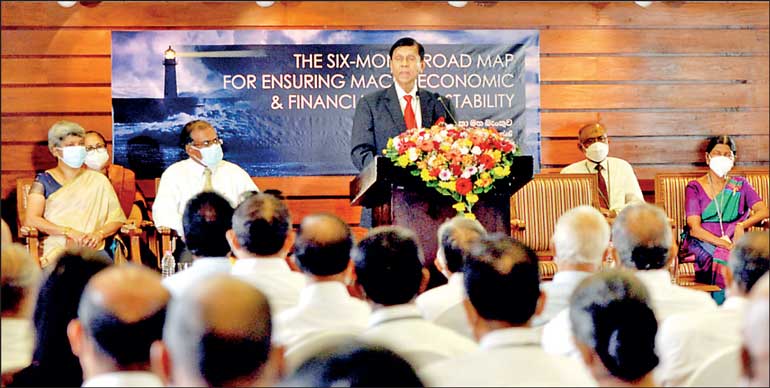
Professionals and citizens are perplexed as to why these leaders feel the essential reform measures of any IMF bailout are not the very same measures that should be followed in any locally developed Road Map
A leading daily newspaper has quoted leaders in charge of the governance of Sri Lanka’s financial stability having purportedly stated on different occasions that;
- If Sri Lanka goes for an IMF bailout, the country has to sign a ‘Letter of Intent’ agreeing to
 all the conditions which are not viable options at this juncture and these will include:
all the conditions which are not viable options at this juncture and these will include:
float the SL Rupee; which will result in the Rupee depreciating to around Rs. 240 to the US Dollar and import costs going up
increase the interest rate; which will have a negative impact on the economy.
dispose of valuable State assets owned by the Government and even privatise the State-owned banks;
no new employees be recruited to the State services and in fact to reduce the present State employee numbers;
reduce subsidies and welfare packages offered to citizens;
place severe restraints on new capital projects and infrastructure spends, including the planned highway extensions, rural roads development projects and enhanced allocations to members of parliament and provincial and local government members:
require withdrawal of restrictions and high tariffs imposed on imports to protect the local farmers/manufacturers and conserve forex reserves
despite all of above being complied with the IMF will not be able to get creditors to agree to restructure the present external debt
- Sri Lanka does not need to go on bended knees to an outside agency to solve the country’s debt problems and has its own capability to manage the external debt commitments without going to the IMF
- The country is now on a path to debt sustainability by changing the present debt profile. Debt obligations can be met and forex crisis resolved by:
moving away from only borrowings to non-debt creating inflows,
reducing exposure to commercial debt and going for government credit lines,
attempting to improve remittance through a ‘carrot and stick’ approach.
Government to government negotiated loans and swaps
- With COVID under control and expected revival in tourism and there will be no debt defaults and better times are ahead,
- IMF Bailout conditionality will destabilise the country and could lead to political instability and even regime change
- Road Map planned cash inflows having been realised, the official reserves position has now reached around $ 3.1 billion. Foreign currency inflows from several other facilities under negotiation at present are expected to be realised in the early part of January 2022.
Professionals and citizens are perplexed as to why these leaders feel the essential reform measures of any IMF bailout are not the very same measures that should be followed in any locally developed Road Map. How come these leaders are blind to the obvious that the Road Map now pursued in fact:
- decelerates growth options,
- drives away potential foreign and local investors, trading partners and technology transferors
- creates disincentives for growth in exports of value-added goods and services and inward expatriate workers remittances
- increases cost of living, creates shortages in essential supplies; all of which severely impact on the poor and vulnerable and growth contributors in the economy
- The stress exerted on commercial banks and their overseas correspondents
- Violates IMF Membership guidelines by having multiple exchange rates
- Fails to address the crisis precipitating lack of fiscal discipline1, losses of State-Owned Enterprises, corruption and money laundering
Current measures placing reliance on short-term swaps, proceeds of asset sales and contractual concessions related to State asset leverage and long-term supply arrangements to fill in the shortfall gaps in regular cash flows are unlikely to ensure longer term debt service commitments without default. None of these measures will enable sustainable financial stability2.
How come these leaders, supported by professionals and technocrats as advisors, all purportedly possessing expertise, experience and aware of governance accountability, (especially as trustees of national resources and voters), make such unrealistic expectations and how come they ignore the following within their strategic Road Map:
- Need to inform all stakeholders of the gravity of the situation, available options to avert a calamity and likely outcomes under each such option (including do nothing and follow present road map), and debt restructure options and thereby secure supportive commitments for implementation of acceptable remedial measures,
- Available options with lenders of last resort or lenders willing to take over the current obligations and replace same with longer dated loan facilities with possible grace periods,
- Options to restructure the existing debt commitments by negotiating for grace periods, extensions in tenor and possible changes in interest commitments and payment frequencies
- Seeking the best available expertise to support restructure of the external debt portfolio (This is what any private sector entity would do, by direct negotiation with the creditors or after using chapter 13 similar options being leveraged, when faced with bankruptcy or debt default lead asset seizure)
- Overvalued Rupee is one of the main causes of the forex crisis and is a deterrent to growing the share of the economy from value added export of goods and services
- Multiple exchange rates with different rates for dollars in the official sources, ‘carrot offer’ based rate for worker remittances and informal kerb market rates are inimical to IMF membership commitments and encourages money laundering, informal markets to boom and is a deterrent to attracting FDI
- Low interest rates lead to under subscribed T Bills/Bonds
- money printing leads to higher inflation
- Continuing budgetary support for loss-making state-owned enterprises and recapitalisation of state banks are inimical to interests of good fiscal management
- Low productivity, overstaffing and low quality of state services is a burden on fiscal management and in vigorously expanding growth options and in improving the ease of doing business indices
- Need for exercise of fiscal discipline in the allocation of scarce national resources and where allocated ensure thing high quality sustainable outcomes and free cash flows from capital investments
- Seek every option to enhance and raise revenue and especially recover earliest the revenue wastefully given up by way of tax reductions and excessive and unwarranted tax concession granted since 2019
- Reverse all erroneous decisions taken and projects initiated that reduce net state revenue
- Restructure all loss-making state entities focusing in priority the large leakage entities
- Introduce a composite social safety-net, with flexibility and rapid action capability, encompassing better design and targeting and direct bank transfers like the Adhar Scheme.
The only logical explanation is that the current leaders are hallucinating!
Footnotes:
1a state of an ideal balance between revenues and expenditure of government,
2https://www.worldbank.org/en/publication/gfdr/gfdr-2016/background/financial-stability - ‘a stable financial system capable of efficiently allocating resources, assessing and managing financial risks, maintaining employment levels close to the economy’s natural rate, and eliminating relative price movements of real or financial assets that will affect monetary stability or employment levels. Financial stability is paramount for economic growth, as most transactions in the real economy are made through the financial system.
The true value of financial stability is best illustrated in its absence, in periods of financial instability. During these periods, banks are reluctant to finance profitable projects, asset prices deviate excessively from their intrinsic values, and payments may not arrive on time. Major instability can lead to bank runs, hyperinflation, or a stock market crash. It can severely shake confidence in the financial and economic system’.

 all the conditions which are not viable options at this juncture and these will include:
all the conditions which are not viable options at this juncture and these will include: